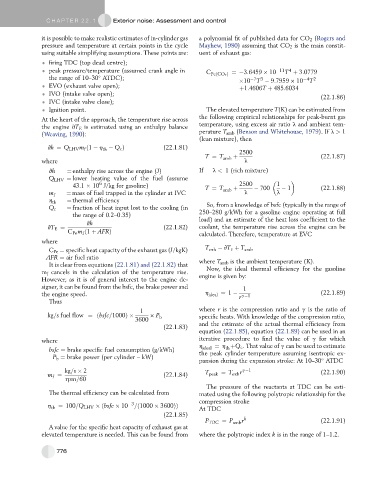Page 765 - Automotive Engineering Powertrain Chassis System and Vehicle Body
P. 765
CHAP TER 2 2. 1 Exterior noise: Assessment and control
it is possible to make realistic estimates of in-cylinder gas a polynomial fit of published data for CO 2 (Rogers and
pressure and temperature at certain points in the cycle Mayhew, 1980) assuming that CO 2 is the main constit-
using suitable simplifying assumptions. These points are: uent of exhaust gas:
firing TDC (top dead centre);
peak pressure/temperature (assumed crank angle in C PeðCO 2 Þ ¼ 3:6459 10 11 4
T þ 3:0779
the range of 10–30 ATDC); 10 7 3 4 2
T
T 9:7959 10
EVO (exhaust valve open); þ1:4606T þ 485:6034
IVO (intake valve open); (22.1.86)
IVC (intake valve close);
Ignition point. The elevated temperature T(K) can be estimated from
At the heart of the approach, the temperature rise across the following empirical relationships for peak-burnt gas
the engine vT E is estimated using an enthalpy balance temperature, using excess air ratio l and ambient tem-
(Weaving, 1990): perature T amb (Benson and Whitehouse, 1979). If l > 1
(lean mixture), then
vh ¼ Q LHV m ð1 h Q c Þ (22.1.81)
th
f
T ¼ T amb þ 2500 (22.1.87)
where l
vh ¼ enthalpy rise across the engine (J) If l < 1 (rich mixture)
Q LHV ¼ lower heating value of the fuel (assume
6
43.1 10 J/kg for gasoline) T ¼ T þ 2500 700 1 1 (22.1.88)
m f ¼ mass of fuel trapped in the cylinder at IVC amb l l
h th ¼ thermal efficiency
Q c ¼ fraction of heat input lost to the cooling (in So, from a knowledge of bsfc (typically in the range of
the range of 0.2–0.35) 250–280 g/kWh for a gasoline engine operating at full
vh load) and an estimate of the heat loss coefficient to the
vT E ¼ (22.1.82) coolant, the temperature rise across the engine can be
C Pe m ð1 þ AFRÞ calculated. Therefore, temperature at EVC
f
where
C Pe ¼ specific heat capacity of the exhaust gas (J/kgK) T exh vT e þ T amb
AFR ¼ air fuel ratio where T amb is the ambient temperature (K).
It is clear from equations (22.1.81) and (22.1.82) that
Now, the ideal thermal efficiency for the gasoline
m f cancels in the calculation of the temperature rise. engine is given by:
However, as it is of general interest to the engine de-
signer, it can be found from the bsfc, the brake power and 1
the engine speed. h ideal ¼ 1 r g 1 (22.1.89)
Thus
1 where r is the compression ratio and g is the ratio of
kg=s fuel flow ¼ðbsfc=1000Þ P b specific heats. With knowledge of the compression ratio,
3600
(22.1.83) and the estimate of the actual thermal efficiency from
equation (22.1.85), equation (22.1.89) can be used in an
where iterative procedure to find the value of g for which
h ideal ¼ h þQ c . That value of g can be used to estimate
th
bsfc ¼ brake specific fuel consumption (g/kWh) the peak cylinder temperature assuming isentropic ex-
P b ¼ brake power (per cylinder – kW)
pansion during the expansion stroke: At 10–30 ATDC
kg=s 2 T ¼ T r g 1 (22.1.90)
m ¼ (22.1.84) peak exh
f
rpm=60
The pressure of the reactants at TDC can be esti-
The thermal efficiency can be calculated from mated using the following polytropic relationship for the
compression stroke
3
h th ¼ 100=Q LHV ðbsfc 10 =ð1000 3600ÞÞ At TDC
(22.1.85)
P TDC ¼ P amb r k (22.1.91)
A value for the specific heat capacity of exhaust gas at
elevated temperature is needed. This can be found from where the polytropic index k is in the range of 1–1.2.
776

